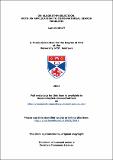Files in this item
On algorithm selection, with an application to combinatorial search problems
Item metadata
| dc.contributor.advisor | Miguel, Ian | |
| dc.contributor.advisor | Gent, Ian G. | |
| dc.contributor.author | Kotthoff, Lars | |
| dc.coverage.spatial | 192 | en_US |
| dc.date.accessioned | 2012-06-22T15:15:52Z | |
| dc.date.available | 2012-06-22T15:15:52Z | |
| dc.date.issued | 2012-06-20 | |
| dc.identifier | uk.bl.ethos.554187 | |
| dc.identifier.uri | https://hdl.handle.net/10023/2841 | |
| dc.description.abstract | The Algorithm Selection Problem is to select the most appropriate way for solving a problem given a choice of different ways. Some of the most prominent and successful applications come from Artificial Intelligence and in particular combinatorial search problems. Machine Learning has established itself as the de facto way of tackling the Algorithm Selection Problem. Yet even after a decade of intensive research, there are no established guidelines as to what kind of Machine Learning to use and how. This dissertation presents an overview of the field of Algorithm Selection and associated research and highlights the fundamental questions left open and problems facing practitioners. In a series of case studies, it underlines the difficulty of doing Algorithm Selection in practice and tackles issues related to this. The case studies apply Algorithm Selection techniques to new problem domains and show how to achieve significant performance improvements. Lazy learning in constraint solving and the implementation of the alldifferent constraint are the areas in which we improve on the performance of current state of the art systems. The case studies furthermore provide empirical evidence for the effectiveness of using the misclassification penalty as an input to Machine Learning. After having established the difficulty, we present an effective technique for reducing it. Machine Learning ensembles are a way of reducing the background knowledge and experimentation required from the researcher while increasing the robustness of the system. Ensembles do not only decrease the difficulty, but can also increase the performance of Algorithm Selection systems. They are used to much the same ends in Machine Learning itself. We finally tackle one of the great remaining challenges of Algorithm Selection -- which Machine Learning technique to use in practice. Through a large-scale empirical evaluation on diverse data taken from Algorithm Selection applications in the literature, we establish recommendations for Machine Learning algorithms that are likely to perform well in Algorithm Selection for combinatorial search problems. The recommendations are based on strong empirical evidence and additional statistical simulations. The research presented in this dissertation significantly reduces the knowledge threshold for researchers who want to perform Algorithm Selection in practice. It makes major contributions to the field of Algorithm Selection by investigating fundamental issues that have been largely ignored by the research community so far. | en_US |
| dc.language.iso | en | en_US |
| dc.publisher | University of St Andrews | |
| dc.rights | Creative Commons Attribution-ShareAlike 3.0 Unported | |
| dc.rights.uri | http://creativecommons.org/licenses/by-sa/3.0/ | |
| dc.subject | Algorithm selection | en_US |
| dc.subject | Combinatorial search | en_US |
| dc.subject | Constraint programming | en_US |
| dc.subject | Satisfiability | en_US |
| dc.subject | Machine learning | en_US |
| dc.subject.lcc | Q325.5K78 | |
| dc.subject.lcsh | Algorithms | en_US |
| dc.subject.lcsh | Machine learning | en_US |
| dc.subject.lcsh | Combinatorial analysis | en_US |
| dc.subject.lcsh | Constraint programming (Computer science) | en_US |
| dc.subject.lcsh | Constraints (Artificial intelligence) | en_US |
| dc.title | On algorithm selection, with an application to combinatorial search problems | en_US |
| dc.type | Thesis | en_US |
| dc.type.qualificationlevel | Doctoral | en_US |
| dc.type.qualificationname | PhD Doctor of Philosophy | en_US |
| dc.publisher.institution | The University of St Andrews | en_US |
This item appears in the following Collection(s)
Except where otherwise noted within the work, this item's licence for re-use is described as Creative Commons Attribution-ShareAlike 3.0 Unported
Items in the St Andrews Research Repository are protected by copyright, with all rights reserved, unless otherwise indicated.


